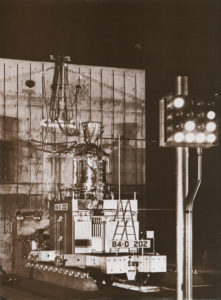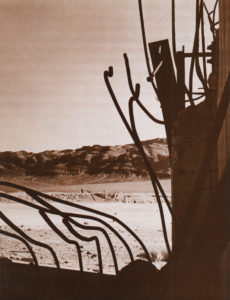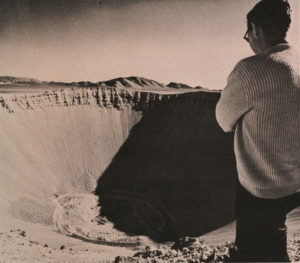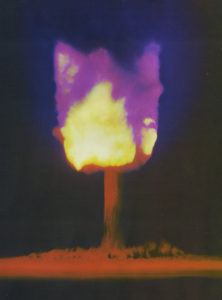Yesterday: Towards Outer Space
Winter 2021
BY JOHN V. YOUNG

If this civilization should vanish in a holocaust that consumes all the records as well as the people, as some gloomy citizens are wont to predict, archeologists of the future may well wonder what crazy species of earthworm once inhabited the southeastern corner of Nye County.
In a land where Mary Austin once said there was “room enough and time enough,” more big, deep holes in the ground have been drilled than anywhere else on earth; one of the nation’s highest towers stands 55 feet taller than the Empire State Building; and time is measured in nanoseconds (billionths of a second). Paradox is a commonplace at the Nevada Test Site, operated since 1951 by the U.S. Atomic Energy Commission as a locale for its arcane experiments with the terrifying power of the atom.
Not only is a large part of the surface of the area pockmarked with the giant dimples euphemistically called “subsidenses” (meaning cave-ins), but a cross section slice of the region below the surface must look something like a great cheese gone bad, a hundred or more caverns filled with melted rock and radioactive debris. It is a question how many such cavities there are, but the AEC has announced 106 underground explosions as of last January which is a fair indication. August 1963 was the month in which the international test ban treaty prohibited all further nuclear tests on or above the surface of the ground. Prior to that date, 99 announced underground tests had occurred and at least 84 atomic “devices” (as the AEC likes to call them) had been successfully detonated in the atmosphere, on towers, suspended from balloons, or dropped from airplanes, on the surface or just below it, all on the same testing grounds. Even the sidewinders have deserted.
For the archeologists of the Post-Atomic Age, there would be still further strange constructions to confuse them, perhaps giving rise to the not-so-far-fetched notion that men had erected giant temples in a clumsy and futile attempt to appease the Atom Gods. These temples would be the massive concrete and steel structures and the labyrinth of tunnels and the acres of huge tanks and pipe farms that comprise the section of the Nevada Test Site known as NRDS (Nuclear Rocket Development Station).
Towards Outer Space
As its name implies, the Nuclear Rocket Development Station is the place where this nation’s pioneer experiments in producing a nuclear-powered engine for propelling rockets into deep space have been carried out in the last eight years. Books have been published and more could be written about this little-known phase of the atomic program, but suffice it here to say that while chemical rockets, depending on combustion, no doubt will put a man on the moon, it will take a thousand times as much energy to reach the nearest planet. Energy of that magnitude can come only from the nucleus of the atom, from a kind of slow atomic bomb acting as a furnace to heat liquid hydrogen. The Nevada Test Site may never see another of those ominously familiar mushroom-shaped clouds rising over it, and it probably never will see an actual nuclear rocket launching, but there seems little doubt that one of its progeny will fly into the sky, one day, from some other location.
The Nevada Test Site, originally some 640 square miles called the Nevada Proving Grounds, was carved out of the Air Force’s old Las Vegas Bombing and Gunnery Range in 1950. It was developed, a little at a time, to provide the AEC, the military, and numerous contractors with a place to test and to study atomic and hydrogen bombs reasonably close to home. The area since has been expanded to cover 1,350 square miles – and is in fact a gigantic and superbly equipped physics laboratory like probably nothing else on earth – just as what happens there is like nothing else on earth.
But from an employment and economic standpoint there is nothing out of the world about the Nevada Test Site for the residents of the region. In what was once one of the least populated and poorest of Nevada counties, there is now work for more than 9,000 people and a monthly payroll in excess of $6,000,000. Those employed include not only scientists, engineers and technicians, but a bewildering variety of other skilled workers including hardrock miners. It has meant construction to date amounting to more than $250,000,000, including some of the most exotic instruments in the world but not counting buildings and equipment necessarily destroyed in tests. To make an omelet, one must break some eggs.
Why so much activity in Nye County, of all places? The area was picked for many reasons, the principal ones being that the government already held vast acreage there, the prevailing winds blow in the right direction, and it is far enough from cities to be safe. Yet at the same time it is close enough to be reached without an overseas flight of 6,000 miles or more as was required by the previous tests in the Pacific Ocean.
From Los Alamos Scientific Laboratory in New Mexico, one of the chief users of the facility and at first its only customer, it is only about 750 miles to the Nevada site. Some of the itinerant staff fly their own planes there and back. From the Lawrence Radiation Laboratory at Livermore, another University of California contract operation, it is even closer.
At this point the often-confusing relationship of Los Alamos and Livermore might be worth explaining. The parallelism is more of a matter of division of labor than of duplication, since there are endless things to do in the nuclear weapons trade. The two big laboratories work on different aspects of the problem, collaborating on some, going their separate ways on others.
For a time Livermore was involved with a project at NTS, a proposed nuclear ram-jet engine experiment called Pluto, that closely resembled a similar effort being made at Los Alamos. When this was phased out by the AEC, the Livermore facility – nicknamed LRL – turned to Plowshare, the peaceful uses of atomic explosions, in which it is now the AEC’s principal contractor. Plowshare experiments at NTS and elsewhere in the United States will be described later.
For the first six years after the AEC took over from the wartime Manhattan District of the U.S. Army’s Corps of Engineers, all atomic weapons testing was carried out exclusively by Los Alamos. Los Alamos scientists detonated the world’s first A-bomb at Trinity site in southern New Mexico in July 1945, and provided the two bombs dropped on Japan the following month to end World War II. After the war, Los Alamos continued to test improved atomic weapons, starting with the dramatic series called Crossroads, at Bikini atoll in the Marshall Islands, when the devastating effect of underwater nuclear explosions on ships was demonstrated early in 1960. Los Alamos designed and tested the first thermonuclear fusion (hydrogen) bomb in 1952, not long before the University of California set up its Livermore laboratory as a branch of the Radiation Laboratory at Berkeley. Livermore soon joined the testing business.
There were drawbacks to the South Sea islands as a test site. Scientists did not like having to spend half their lives so far from home; the military did not like having to tie up a small army and navy to supply the project. As far back as 1947, it was recognized that a supplemental test site in the United States would be less expensive in dollars and manpower, would reduce the time for assessing test results, and would cut weapons development lead time.
Cold war and Korean developments made the continental site a necessity. Review of fallout, thermal and blast information gained in the Pacific led to the decision that a site in Nevada could be used for relatively low yield nuclear detonations with full assurance of public safety.
The Pacific continued as the location for higher yield tests through the 1962 series that included some high-altitude rocket shots from Johnston Island. And Johnston Island has been maintained in a state of readiness for high-yield atmospheric testing in the event international developments should force a renewal of such tests.

Testing Begins In Nevada
The Pacific tests demonstrated that it was possible to conduct some fairly large-scale experiments with safety. Nevertheless, the idea of having A-bombs going off like firecrackers in one’s backyard was a bit of a shock to Las Vegas at first, but after the first dozen or so blasts had broken a few windows, the townspeople ignored them. The croupiers did not so much as miss a roll of the dice when the sky lit up and the chandeliers shook. Later, there were a few protests from several small towns in Utah and eastern Nevada about fallout from clouds caused by some of the tests, but since they have all gone underground even this relatively minor inconvenience no longer poses a threat. People can get used to anything, even sonic booms.
For peaceful or military or Civil Defense tests, atomic bombs have been fired at NTS under a wide variety of conditions since the first one ever exploded in Nevada-the second on this continent-was dropped from an airplane on January 27, 1951. This was the first of a series of five called Ranger. In 1953 an atomic artillery shell was shot from a cannon, and in 1957 an air-to-air nuclear missile was detonated over the site. The list since then is too long to detail here.
Harnessing The Atom
Work at the Nevada Test Site, however, has not all been bombs. It has gone far beyond the original concept, and now has almost as much to do with peaceful uses of nuclear energy as with those of war. Big nuclear reactors – of the type called “promptcritical” because they get very hot very fast – are being tested there now, as one example.
It is for this sort of experiment that the tall tower mentioned earlier was erected – to put a nuclear reactor 1,527 feet high into the air for a variety of highly technical purposes. The tower is called BREN, meaning Bare Reactor Experiment, Nevada, the word “bare” indicating that the business portion of the reactor is surrounded by air instead of the usual thick shielding.
One of the more understandable experiments as far as the layman is concerned was that in which BREN was used to test the shielding characteristics of some Japanese-style houses erected under the tower to determine how much radiation occupants of similar houses might have received when atomic bombs were dropped on Hiroshima and Nagasaki. There are, of course, many other uses for specific information on the behavior of big reactors in an air environment.
Livermore and Los Alamos share a keen interest in what has become a special branch of nuclear physics in its own right, the study of unnatural elements and their isotopes produced by underground nuclear explosions. Simply stated, the biggest and best of all possible sources_ of nuclear particles is an exploding A-bomb. When a bomb is placed underground and surrounded with various materials, it is possible to recover samples by drilling into the cavity following the explosion and to find all sorts of strange things. Among them are some of the heaviest elements ever seen by man, in amounts vastly greater than could be produced in any laboratory.
Under the heading of Plowshare, the Livermore facility is studying the possible use of nuclear devices for what the AEC chooses to call “geographical engineering.” This is the exciting idea of moving huge amounts of earth in a hurry by means of nuclear explosions – for sea-level canals between oceans, stripping waste rock from deep-lying mineral deposits, cutting highway and railway passes through mountains, creating new harbors and lakes, and possibly even altering the shape of entire watersheds for better water distribution. That is not all. The Plowshare people see the possibility of constructing huge subterranean reservoirs, stepping up oil and gas production, producing industrial steam, converting some minerals directly into usable chemicals, and the desalting of sea water -all by means of underground A-bombs. Vast reserves of oil and gas are locked in shales and sands beyond economical recovery by any means known today. Plowshare may do the job with a bang. Such a project, called Gasbuggy, is scheduled for late this year in the San Juan gas fields near Farmington, N.M.

Perhaps it is poetic justice that Nevada, so long tied to mining for its economy, may well become the birthplace of a drastically new way of excavating the earth’s hidden riches.
The Lawrence Radiation Laboratory is assisted in its field work and testing operations by the Sandia Laboratory of Albuquerque, operated by a subsidiary of the Western Electric Company for the AEC. Originally a small ordnance engineering division of Los Alamos situated at Kirtland Air Base, Sandia began operating under a separate contract in 1948 and now is about twice the size of its parent. It has overall responsibility for the development, testing and production of non-nuclear components of atomic and hydrogen bombs, and is particularly concerned with electrical and electro-mechanical devices and with telemetry and rocketry. In addition, it maintains close liaison with Los Alamos and with the Department of Defense.

Sandia shares with Los Alamos and the Lawrence Radiation Laboratory the joint responsibility for keeping the nation in a state of readiness to resume testing in the atmosphere should the present test-ban treaty be abrogated by Russia. Sandia and Los Alamos carry major roles in Project Vela, the development of devices for detecting nuclear explosions (ours or anyone else’s) on or above the earth or far out in space. The AEC has provided unique flying laboratories to all three laboratories. These are converted military four-engine jet transport planes equipped with all manner of ultramodern instruments. They have various uses including the solar eclipse observations in 1965 and 1966 in the southern hemisphere when scientists from the laboratories and their exotic flying machines participated.
Sandia also assisted Los Alamos and the Lawrence Radiation Laboratory with instrumental rocket launchings during the solar eclipses, and provided rocketry and telemetering for a Los Alamos study of the aurora borealis at Hudson’s Bay early in 1964. These are typical of many interlaboratory operations.
Regardless of whom they work for, all the people assigned to the Nevada Test Site check in through the extraordinary company town of Mercury, Nevada, five miles north of the junction with U.S. 95. The highway to Las Vegas was widened to four lanes a few years ago, incidentally, because of the heavy traffic to and from the site.
Mercury, the administrative and support headquarters for NTS has no family housing. Although hundreds of women work there it definitely lacks the feminine touch. Everybody lives in dormitories, or in trailers. The town has its own post office and telephone exchange, a bowling alley and a chapel, a movie theater, cafeterias, a steak house and belatedly an Olympic-sized swimming pool. But it is still a camp far out in the desert with no place for the wife and kids, and most of the highly trained people working there permanently prefer to commute the 70 miles from Las Vegas by private car or in one of the fleet of 54 big buses provided for the purpose.
On the road between U.S. 95 and Mercury stands a ghost town, Camp Desert Rock, used by the Army during field exercises involving nuclear explosions in the 1950’s. At one time housing 5,000 men, it is now almost entirely deserted except for its mile-long airstrip serving the Test Site. Roads lead from Mercury to such places as Frenchman’s Flat, famous as the site of the first atomic tests in 1951. It, too, has a ghost town of sorts, consisting of a variety of badly damaged structures put there to demonstrate what an atomic blast can do to a town. Located on a saddle beyond Frenchman’s Flat is the original Control Point. As its name implies, it is the control station for atomic tests both at Frenchman’s Flat and Yucca Flat since it overlooks both test areas. Yucca Flat, a vast dry lake supporting an 11,000-foot airstrip, is covered at times by a few inches of water after an unusually heavy rain. Then it is called Yucca Lake.

Numerous other test areas, all closed to the public, are now in operation. Probably the most spectacular is the one containing the huge Sudan Crater. This great man-made depression, or subsidence, 1,280 feet in diameter and 320 feet deep, was created in a matter of minutes by the detonation of a 100-kiloton thermonuclear bomb buried 635 feet underground, on July 6, 1962. The most distant test area at Pahute Mesa, 70 miles from Mercury, is being developed for tests of bigger bombs, perhaps a mile underground. It is situated in high, rugged terrain best suited for goats.
The Nuclear Rocket Development Station, situated in the extreme southwestern corner of the Test Site, is only about a dozen miles from Lathrop Wells where a second entrance is available to test personnel. NRDS is operated by a unique organization called SNPO. Pronounced “snoopo,” SNPO stands for Space Nuclear Propulsion Office and is a joint enterprise of the AEC and NASA. Created in 1958 in an area known as Jackass Flats, NRDS was first used to test a nuclear rocket reactor known as Kiwi on July 1, 1959, and since then has seen many additional Kiwi-type tests under the project title of Rover. The Kiwi reactors, named for the flightless New Zealand bird because they were not designed to fly, have since been replaced by larger and more powerful reactors of the Phoebus series. Adaptation of these reactors to rocket engines is the work of two other contractors, Westinghouse and Aerojet General, which carry on much of their work at NRDS also under the name of NERVA (Nuclear Engine for Rocket Vehicle Application).
As it would be inevitable in dealing with any large area of Nevada real estate, an old mining camp and a number of archeological sites are within the confines of the Test Site. Much care has been taken to preserve such relics, but where construction has affected them, salvage archeology has been carried out, resulting in the addition of much material bearing on the prehistory and history of the region.
While all the site is closed to the public, parts of it are opened on special occasions for educational tours, and are also visited by groups in some way connected with the work.

